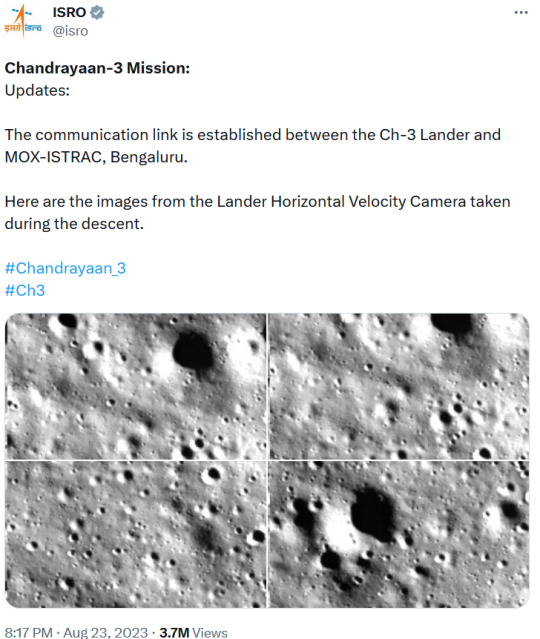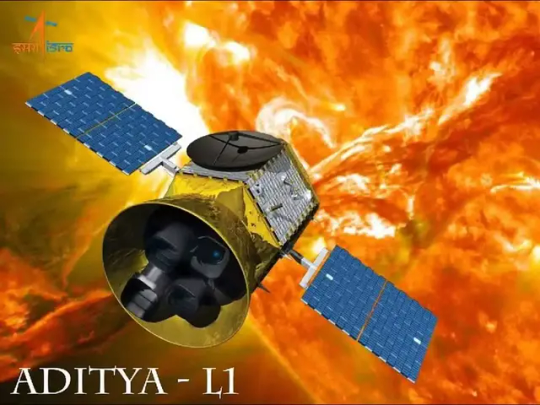#isro aditya l1
Text
youtube
Aditya L1 Launch: चांद के बाद अब सूर्य पर भारत, आदित्य एल-1 किया गया लॉन्च
भारत अंतरिक्ष अनुसंधान संगठन (ISRO) आज शनिवार को सूर्य का अध्ययन करने के लिए अपना आदित्य-एल1 मिशन (Aditya L1 Mission) सफलतापूर्वक लॉन्च कर दिया है। आदित्य एल1 मिशन चंद्रयान-3 मिशन के समान दृष्टिकोण अपनाएगा।
#चांद के बाद अब सूर्य पर भारत#आदित्य एल-1 किया गया लॉन्च#aditya l1 mission launch date#isro mission#isro mission to sun#what is aditya l1 mission#aditya l1 mission#aditya l1 mission news#aditya l1 mission kya hai#isro aditya l1 mission#aditya-l1 mission#aditya l1 mission in hindi#isro sun mission aditya l1#isro sun mission#aditya l1 mission reaction#isro aditya mission#aditya l1 mission sun#isro aditya l1#isro aditya l1 mission live#aditya l1#Youtube
0 notes
Text
India launched its first space mission to study the sun on Saturday, less than two weeks after a successful uncrewed landing near the south polar region of the moon.
The Aditya-L1 spacecraft took off on board a satellite launch vehicle from the Sriharikota space center in southern India on a quest to study the sun from a point about 1.5 million kilometers (930,000 miles) from earth, known as L-1.
The spacecraft is equipped with seven payloads to study the sun's corona, chromosphere, photosphere and solar wind, the Indian Space Research Organization said.
After over an hour, the ISRO said the launch was "accomplished successfully."
Continue Reading.
127 notes
·
View notes
Text
its launched! evrythings normal!! except me im not normal about this at alll
10 notes
·
View notes
Text
Aditya-L1 launch: Meet the women who oversaw the success of the Sun mission
6 notes
·
View notes
Text
ISRO Aditya L1 Satellite: Illuminating India's Journey into the Sun
Introduction:
The Indian Space Research Organisation (ISRO) has been making remarkable strides in the field of space exploration and research. One of their latest endeavors, the Aditya L1 satellite, is set to embark on an extraordinary mission—studying the Sun and its dynamic behavior. In this article, we delve into the significance of the Aditya L1 satellite and how it promises to contribute to…

View On WordPress
5 notes
·
View notes
Text


Hello Moon!!! 🚀🌑
India is now the 4th nation to land successfully on the moon, thanks to the national space agency ISRO (Indian Space Research Organization). Chandrayaan - 3 (literal meaning: mooncraft) is a successor of a previously failed mission Chandrayaan - 2. Back in 2019, CH-2's lander lost contact barely 2 km above the surface of the moon, absolutely breaking so many hearts.
But not the will! Because what the scientists learned from the crash, they corrected. So much so that, when CH2 was landing, it still had a downward speed of 58 m/s (210 km/h). Too much! This time, though? This time it landed with a velocity of less than 2 m/s!! A brilliant soft landing!
Kudos to the ISRO team, may you fly us farther and farther!
2 notes
·
View notes
Text
Aditya-L1: ISRO’s Next Mission Will Take India To The Sun.

New Delhi: The Indian Space Research Organisation (ISRO) on Monday announced the launch date for its solar mission Aditya-L1 spacecraft. On September 2 at 11:50 am, the mission to study the sun will take off from Sriharikota Airport.
ALSO READ MORE- https://apacnewsnetwork.com/2023/08/aditya-l1-isros-next-mission-will-take-india-to-the-sun/
#Aditya sun mission#Aditya-L1: ISRO’s Next Mission Will Take India To The Sun#ISRO#isro Aditya sun mission#isro sun mission#ISRO’s Next Mission Will Take India To The Sun#sun mission
0 notes
Photo



(via आदित्य एल1: इसरो का पहला सोलर मिशन ,मिशन का उद्देश्य, लैग्रेंज बिंदु)
0 notes
Text
India's First Solar Mission: Aditya-L1
India has achieved yet another milestone in its space exploration with the successful launch and orbit insertion of Aditya-L1, the country’s first mission dedicated to study the Sun. Aditya-L1 is a solar observatory that will observe the Sun from a unique vantage point, the Lagrange Point 1 (L1), where the gravitational effects of the Earth and the Sun balance each other. This will enable the…
View On WordPress
0 notes
Text
Aditya-L1: India's Pioneering Solar Mission Set to Enter Orbit Today
Introduction:
In a significant milestone for India’s space exploration endeavors. The Indian Space Research Organisation’s (ISRO) Aditya-L1 To Enter Orbit today mission, the nation’s first solar observation mission, is poised to reach its final destination orbit today. Launched on September 2, 2023, from ISRO’s Sriharikota launchpad. The Aditya-L1 mission is a testament to India’s commitment to…

View On WordPress
#Aditya-L1 carries seven payloads#Aditya-L1 mission#Aditya-L1 To Enter Orbit today#Indian Space Research Organisation&039;s (ISRO)
0 notes
Text
Aditya-L1: India's Pioneering Solar Mission Set to Enter Orbit Today
Introduction:
In a significant milestone for India’s space exploration endeavors. The Indian Space Research Organisation’s (ISRO) Aditya-L1 To Enter Orbit today mission, the nation’s first solar observation mission, is poised to reach its final destination orbit today. Launched on September 2, 2023, from ISRO’s Sriharikota launchpad. The Aditya-L1 mission is a testament to India’s commitment to…

View On WordPress
#Aditya-L1 carries seven payloads#Aditya-L1 mission#Aditya-L1 To Enter Orbit today#Indian Space Research Organisation&039;s (ISRO)
0 notes
Text
ISRO prepares for critical maneuver as Aditya L1 is set to reach its destination on January 6
The Indian Space Research Organisation (ISRO) stands at the edge of groundbreaking achievement with its first solar mission, Aditya-L1.
The chairman of ISRO, S Somnath has disclosed that the spacecraft is set to arrive at its designated destination, the L1 point, on January 6, 2024, after covering a distance of 1.5 million kilometers through space. He stated that the insertion of Aditya-L1 into the L1 point is slated for January 6, 2024, but the specific time is yet to be determined.
L1, also known as Lagrange Point 1, holds a strategic position in space where the gravitational forces of the Earth and the Sun balance out each other, enabling a spacecraft to sustain a stable position relative to both celestial bodies. This exceptional vantage point offers an uninterrupted view of the Sun, turning it into an ideal location for solar observations.

The inception of the Aditya-L1 mission dates back to January 2008, originating from the Advisory Committee for Space Sciences (ADCOS). Initially conceived as a modest 400 kg satellite orbiting 800 km above Earth, the mission expanded its scope to encompass an extensive study of the Sun’s corona from a distance of 1.5 million km away from our planet.
To Read More Click here...
#science#new features#new updates#Aditya L1#new mission#January 6#Isro#critical maneuver#spacecraft#planet
0 notes
